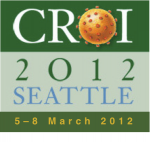Case report: homozygous CCR5 delta-32 protection overcome by infection with X4 virus
1 April 2012. Related: Conference reports, HIV prevention and transmission, CROI 19 (Retrovirus) 2012.
 Simon Collins, HIV i-Base
Simon Collins, HIV i-Base
A sobering and important report documented the case study of a man who was homozygous for the CCR5 delta-32 mutation that generally provides effective protection against infection from HIV.
With most circulating (and infectious) virus using the CCR5 co-receptor, individuals with this deletion in both chromosomes who are exposed to HIV provide a dead-end for the infection, with the virus unable to infection CD4 cells without the use of the coreceptor.
This case of a 39 year-old man – who was diagnosed in 1996 – was indentified by Ester Ballana and colleagues after retrospectively testing DNA from stored peripheral blood mononuclear cells (PBMCs). The man had started treatment within 6 months of diagnosis, at a CD4 count of 520 and viral load of 3,500 copies/mL. Sequence analysis of the env gene idicated homogeneous X4 virus.
Fifteen years after seroconversion, total HIV-1 proviral DNA was 60 copies/million PBMCs. CD4 count had only increased to 600-700 over this time but HLA haplotype analysis showed multiple alleles associated with slower HIC progression including HLA-B*5701 and HLA-A*2402.
Ref: Ballana E et al. HIV-1 infection in a CCR5-D32/D32, HLA-B*5701, and HLA-A*2402 subject: a case report. Poster abstract 292.
http://www.retroconference.org/2012b/Abstracts/43778.htm

